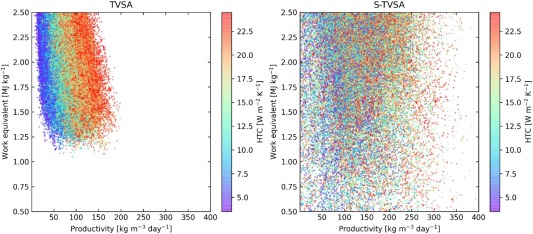J. Young, F. McIlwaine, B. Smit, S. Garcia, and M. van der Spek, Process-informed adsorbent design guidelines for direct air capture Chem Eng J, 141035 (2022) doi: 10.1016/j.cej.2022.141035

Abstract: Direct air capture using solid adsorbents is a proven technology critical to reducing our net greenhouse gas emissions to zero and beyond. Currently, academic research into the technology mainly focuses on the development of new adsorbents. However, there is a discord between the adsorbent design and process performance. Many materials scientists focus on maximising metrics such as the CO2 capacity of their adsorbent. Here, we combine detailed process modelling, machine learning, and extensive global sensitivity analysis, which entails varying all of the model parameters together, on a direct air capture process to show that the dry CO2 adsorption capacity does not influence process performance for an amine-functionalised adsorbent operating in a temperature vacuum swing adsorption (TVSA) process, while it is important in a steam-assisted TVSA (S-TVSA) process. In fact, adsorption kinetics, density, and thermal conductivity are all critical attributes to obtaining a low energy penalty and reduced costs. The analysis also highlights the importance of heat transfer, directing process engineers to (alternative) adsorber designs that maximise this. By an in-depth evaluation of how process performance indicators are affected by materials properties and process operating parameters, this work provides guidance to both material scientists and process engineers towards the design of a “unicorn adsorbent” and intensified DAC processes. This will improve the performance of solid adsorbent direct air capture and help drive down the costs of this vital technology to avert the worst impacts of climate change.